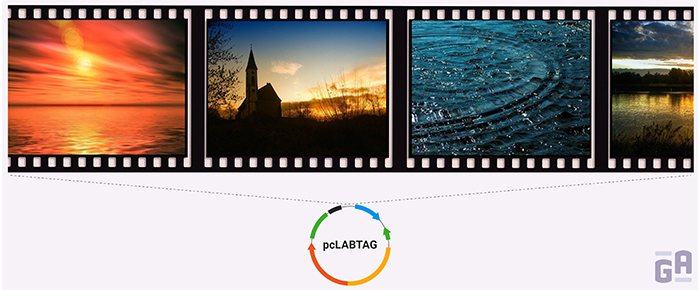
Turning information into objects
In 2019, a paper published in Nature Biotechnology by Julian Koch and his colleagues at ETH Zürich described a protocol where information was stored in DNA, then encapsulated in silica capsules and mixed with polycaprolactone, a biodegradable thermoplastic polyester.1 The encapsulation of the DNA prolonged its lifespan and protected it from degradation at room temperature, while the information encoded on in the DNA included blueprints for how to 3D print a Stanford Bunny—frequently employed as a test three-dimensionally computer graphics—using the nanoparticles. To do this, they encoded 12,000 separate DNA oligonucleotides that stored the 45kB of data needed to build the rabbit by applying a DNA encoding scheme called DNA Fountain, which converts each 00, 01, 10, and 11 of data to A, C, G, and T bases and forms small oligo “droplets.” The algorithm then screens the droplets to make sure they have the correct properties, such as low GC content and no homopolymer runs (e.g. AAAAAAAAAA), to avoid synthesizing or sequencing errors. Larger oligos can then be designed using these droplets.2
Eventually, they 3D printed the rabbit and used a small chunk of its ear to retrieve and decode the information stored in it. They used PCR to amplify the DNA from the rabbit chunk, sequenced the DNA library with an Illumina MiSeq flow cell, and recovered the original oligo droplets. They then used an algorithm to convert the data from each droplet (A, C, G, T) back into its original code (00, 01, 10, 11).
While their rabbit represents an interesting way of preserving blueprint data (mimicking what we, as organisms, do) that can one day be developed into a new method of storing medical information in medical or dental implants, Koch et al found yet another use for their technology. Instead of using polycaprolactone, they encoded a 2-minute video of documents found in the Warsaw Ghetto during the Holocaust, fused their DNA silica capsules to plexiglass, molded it to the shape of a lens, and fit it inside the frame of a pair of glasses. By doing this, they can hide sensitive information in everyday objects that are compatible with their DNA capsules. Those looking to intercept the data won’t necessarily be able to assess where the data is hidden because the object looks exactly like any other pair of glasses, and even if they know where the information was hidden, they wouldn’t be able to discern the annealing sites to amplify the message properly.
Storing data in living cells
Inanimate objects aren’t the only things capable of storing encoded information via DNA: living organisms can also be engineered to store data that codes for movies, music, and images. Seth Shipman, currently working at the University of California San Francisco, published a paper in 2017 wherein he encoded a digital movie into many individual oligos.3 In this case, the oligos were termed “protospacers” for their ability to integrate into the genome of the bacteria E. coli using the CRISPR/Cas system. In their system, each frame of the movie was encoded by 104 protospacers, containing a total of 2.6 kB of data. The order of the frames was determined by the order with which the protospacers were incorporated into the culture. New spacers are always acquired directly adjacent to the old spacers, so Shipman and his group were able to distinguish the frames by observing the pairwise order of spacers in the cultures. Ultimately, they were able to isolate and amplify the sequences, reconstructing the exact same digital movie that had been incorporated into the bacterial culture.
LabTAG by GA International is a leading manufacturer of high-performance specialty labels and a supplier of identification solutions used in research and medical labs as well as healthcare institutions.
References:
- Koch J, Gantenbein S, Masania K, Stark WJ, Erlich Y GR. A DNA-of-things storage architecture to create materials with embedded memory. Nat Biotechnol. 2019:1-7.
- Erlich Y, Zielinski D. DNA Fountain enables a robust and efficient storage architecture. Science. 2017;355(6328):950-954.
- Shipman SL, Nivala J, Macklis JD, Church GM. CRISPR-Cas encoding of a digital movie into the genomes of a population of living bacteria. Nature. 2017;547(7663):345-349.